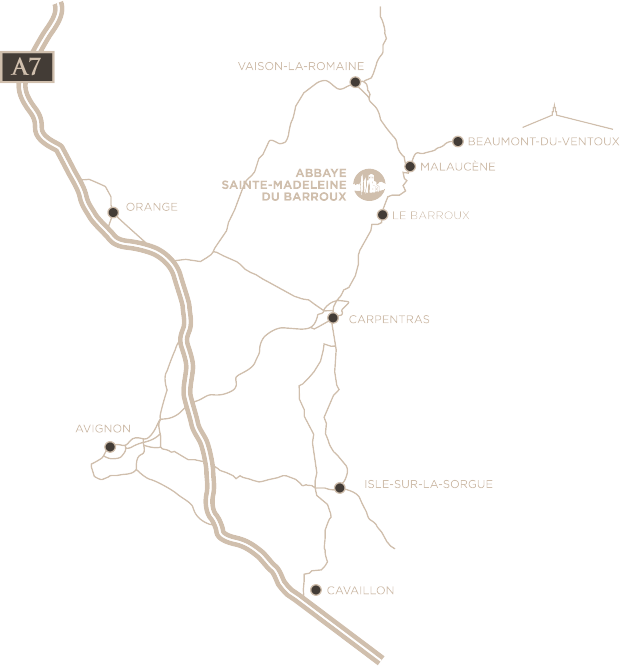This is our share of a very rich heritage, these are the fruits of the past which we harvest now. But, brethren, this present time in a little while will also pass, but it suffices that we, in turn, plant trees: they will bear fruit one day for the hands already raised beyond the mists where, before us, the future dawns. Come, we shall never be so rich, we who will pass as those who are preparing to come, that we can afford to waste anything, even a perfume, of this family treasure.
Max-Philippe Delavouët
480 :
A key date in the history of Europe and of wine
Benedict was born in Nursia, in central Italy, the son of a Roman patrician. After brief studies in Rome, the young Benedict decided to withdraw to the desert and become a hermit monk. The radiance of his prayer life attracted many disciples to him, and Benedict founded a first colony of monks in Subiaco before building the famous monastery of Monte Cassino, citadel of Campania and cradle of the Benedictine order. Unwittingly and unintentionally Benedict thus wrote, as we all know, an important page in the history of Europe, but he also had a significant impact on the history of wine.
In the following centuries, his monks, faithful to the Rule of their founder, devoted themselves with unflagging courage to working in the fields, knowing that “they are truly monks if they live by the labor of their hands” (Rule of St Benedict). The vineyard became one of the most favored places of this labor, where the sons of St Benedict would invest the patience and ingenuity, of which they had been given the secret, to develop the lands entrusted to them to their full potential. Clos de Vougeot, Romanée-Conti, Châteauneuf-du-Pape, Gigondas, Vaqueyras… are just some of the unforgettable vineyards that were created by the monks.
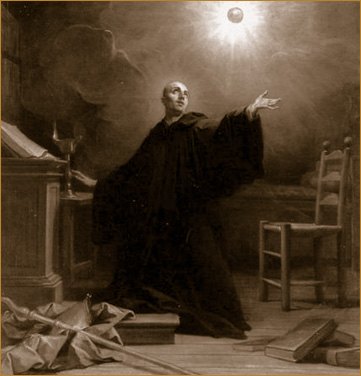
1305-1314 :
Clement V and the Pontifical Vineyard in the foothills
of Mont Ventoux, in Benedictine Territory
Bertrand de Got, a native of the region of Bordeaux, was elected archbishop of that city around the year 1300. As someone fond of fine wines and especially in order to meet the needs of the liturgy, he planted a vineyard in Pessac. This was the origin of the current Château Pape Clément.
The Sacred College met in Perugia and elected him as the first pope who would rule outside Rome. He then left the Guyenne area to travel to Lyon, where he was enthroned under the name of Clement V in September 1305. Chroniclers tell us that twenty casks of new wine offered by the King of England followed the papal escort.
In 1309, the Pope permanently left the Aquitaine region and settled in the Comtat Venaissin, already a pontifical territory for thirty-five years. He arrived in Avignon on March 9, 1309 and took up his residence in the Dominican convent. He sometimes stayed at the castle which would become the famous Châteauneuf-du-Pape. But he also resided in Carpentras and whenever possible, he took time off in the surrounding countryside.
This Pope liked quiet places where nature expresses by her beauty and peace the indescribable Beauty of the Creator.
He chose the small town of Malaucène in the foothills of Mont Ventoux as a vacation resort. The north face of Mont Ventoux and the fountain of the Groseau made it a place of coolness and silence, conducive to meditation and prayer.
Upon his arrival, the jubilant population welcomed him, gathered around the Bishop of Vaison, (Raymond, lord of Beaumont), the clergy, the noblemen, and the local monks. Initially, he was taken to the feudal castle, a tower of which remains to this day in Beaumont du Ventoux. The Benedictine monks then yielded their monastery of the Groseau to the Holy Father and moved their entire community of thirty brothers to the center of Malaucène where they owned a priory, or perhaps to their other priory of the Madeleine, on the road to Entrechaux. It was therefore in this enchanting place of the Groseau source that the Pope willingly went to gather his thoughts and to receive his friends, passing there all of his moments of freedom and convalescence. This is also where he signed many official acts during his pontificate.
As he had done in Pessac, Clement V planted vineyards, making Malaucène the first papal vineyard.
Formerly bishop of Avignon, John XXII established his papal court there. He was responsible for the creation of the papal vineyard of “Chateaneuf-du-Pape”, then named Calcernier. The castle in the village served as a second home to popes and as a shelter in case of attacks on the road or by enemy armies. John XXII had vineyards planted there by his fellow countrymen of Cahors.
Appreciative of fine wines, this Pope had served at the pontifical table the younger more recent wines from the entire Rhône Valley, from Hermitage to St. Remi de Provence. For his older wines, he remained faithful to the legacy of his predecessor, relying on the sweet wine of Malaucène, whose vineyard annually provided seven saumées of “vin de paille” (the saumée was equivalent to 110 liters). He was not drawn to the Groseau in the same way as his predecessor, but the wine from this little lost paradise continued to delight guests at the papal table! Later, the winegrowers of the area were not to forget this, and renewed the tradition of making this unusual wine from dried grapes.
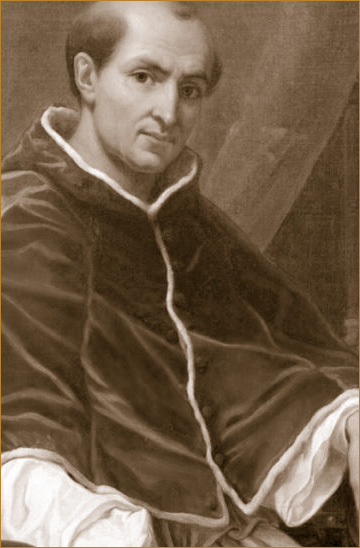
1929-2015 :
the winegrowers in the mountains of Beaumont du Ventoux
inherit the Pope’s Vineyard
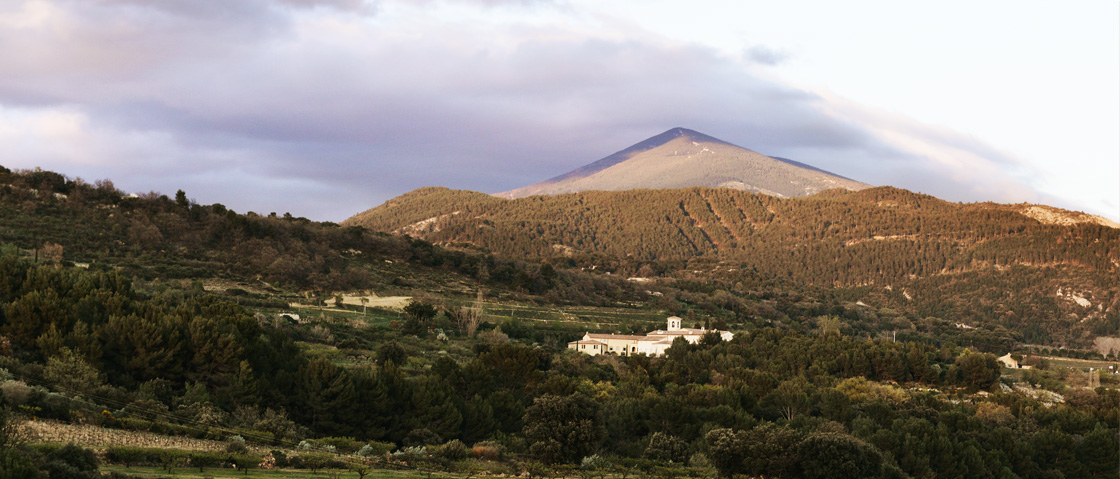
At the end of the First World War, virtually everyone in the canton of Beaumont du Ventoux made their living from agriculture. Life was harsh but the inhabitants had become accustomed to being content with what they had. In addition to the wild lavender on Mont Ventoux, lavender was cultivated, and vines and orchards were grown wherever wheat grew poorly.
Before 1929, wine grapes were picked by intermediate employees. The crates were provided by the winemakers and one had to wait until they were delivered before starting the harvest. Then one had to wait until these winemakers got around to collecting the picked grapes, and weighing them in the fields. Memories abounded of full crates being abandoned for lengthy periods, waiting by the side of a field or a road, or even in Malaucène’s central square. And finally, one had to wait to be paid, if one was paid at all. Waiting, waiting… and more waiting!
In Beaumont, one man was to leave his mark on the village: the mayor Adrian Blouvac. He had something of the former Lord of Beaumont in his blood: wisdom, a keen sense of the common good and the pugnacity of men from the mountains! And he was assisted by a very capable team. The teacher and secretary to the mayor, Alain Charasse, and several farmers with strong characters helped create the core necessary for the birth of a winery. The project progressed. The winery would be cantonal, grouping together the winegrowers around Malaucène, the former papal residence where the first papal vineyard was planted. On March 24, 1929 the winery was formerly established and construction was well underway. Four years later, on January 29, 1933 it was completed and wine flowed freely to celebrate this event.
The winery grew, surviving the global economic crisis of 1933, which affected the wine market, and then the Second World War, in which it helped to unify the local population.
After the war, peace and tranquility having returned, the winegrowers continued their quest to make high quality wines, which came to benefit from the status of “AOC Ventoux” (Appellation d’Origine Contrôlée, or Protected Designation of Origin) on July 27, 1973. In this regard, long-term work was undertaken on the vineyards, to enhance their potential: Grenache Noir, the noble grape of southern regions, took the main place in our vineyards; old Carignan vines were carefully preserved; and Syrah (Shiraz) began to be widely planted for its color, fragrance and ability to age. Cinsault also became widely planted, because like Syrah, it participates in the overall harmony of the final blended wine.
From this viewpoint of seeking higher quality, the construction of a wine store for retail sales was of primary importance. In 1981, the new store was inaugurated at the boundary between the communes of Le Barroux and Malaucène, along the road which links Vaison la Romaine and Carpentras.
The winegrowers’ vineyards increased from 100 ha (250 acres) in 1929 to 300 hectares (750 acres) in 2015. The winery remains one of the smallest in the Vaucluse area and this feature allows us to work together, like a large family property. Each plot is very carefully followed throughout the vintage and each winegrower works for particular goals depending on the capacity of their vines, helped in this by the valuable advice of Miguel Varo who tirelessly surveys the winery’s entire vineyard in order to determine the best strategies to be implemented.
Whether from Le Barroux, Beaumont or Malaucène, all of our winegrowers treasure the fact that their roots are in the heart of the Provence of the Popes, and their special heritage as a member of the winery of the canton of Malaucène, and their special heritage as a member of the winery of the canton of Malaucène. In 1995, the winegrowers renewed their bonds with this great tradition by producing a “vin de paille,” which is no doubt very similar to that produced from the small papal vineyard planted by Clement V and which his successor John XXII liked to serve to his distinguished guests.
Again encouraged by their awareness of being the inheritors of a unique legacy, the Beaumont winegrowers undertook a particularly audacious venture in 2003: the restoration of the old bancaous (terraces in the Provence dialect) some of which date from the Gallo-Roman era, and creating exceptional vineyards, cultivated according to specifications previously unheard of in Provence: high-density planting (7,500 vines per hectare), tall trellis training lines on wooden stakes, a meticulous task carried out almost entirely by hand: pruning, removal of non-fruiting buds, elimination of suckers; early removal of some of the grapes (to avoid having too many), pollarding (to obtain a balance between grapes and leaves), thinning the leaves (to increase ventilation of the grapes and prevent rot): every effort is made in order to obtain what could otherwise only be dreamed of: the most highly concentrated grapes, enabling the best possible expression of our terroir.
1986-2010 :
The return of the Benedictines..
to the Beaumont du Ventoux Winery!
In 1309, as we saw, it was the Benedictines of the Groseau and the Madeleine who gave their monastery to Pope Clement, thereby giving him the opportunity to plant the first papal vineyard. In an amusing historical twist, 677 years later, it was the winegrowers of the canton of Malaucène, the inheritors of these vineyards, who welcomed the Benedictine monks of St. Madeleine back: a community approved directly by the Pope, recently established outside the village of Le Barroux, on Malaucène’s borders. The story of this return is itself quite amusing.
For the monks of the Abbey of Sainte Madeleine, who arrived in 1970 at the priory of the Madeleine of Bédoin at the foot of the south face of Mont Ventoux and who then moved to Le Barroux in 1980, their wine adventure began in 1986 with the arrival of the nuns of the Abbey of Our Lady of the Annunciation! These nuns, living first in Montfavet then at Uzes, were seeking a place to settle near the monks of Ste Madeleine of Le Barroux and their founder, Dom Gerard, who remains the Father of their own community. The nuns found a property quite suitable for their purposes, just a few kilometers from Sainte Madeleine. This haven of peace was called Font de Pertus and it was a wine property! Chance or another providential sign? In monasteries, it is said that “chance” is Providence who prefers to work in secret!
In moving there, the sisters made a commitment to maintain the Font de Pertus vineyard; they therefore set to work with the help of neighbors. It was not long before the monks also planted a vineyard at the base of their hill, entrusting its care to a local friend and winegrower. The grapes from the two abbeys were vinified as if they came from a private property, at the Beaumont du Ventoux Winery. One of the monks was given a place on the winery’s board of directors. This collaboration reflected the involvement of the two monasteries in the surrounding winegrowing community, but the monks and nuns could not stop there…
“And Noah, a man of the soil, began to plant vines…” Like the patriarch, the first winegrower, the monks began to devote themselves to this noble task: gradually, they carried out not only the harvests but also the entire vine-growing cycle. The challenge was well worth it: their monasteries were indeed located on a land of tradition, the Côtes du Ventoux, whose vineyards date back to Roman times; and as we said, in the fourteenth century, Pope John XXII ordered this same wine for his table! The village of Le Barroux enjoys a superb location; the Mediterranean climate ensures sunshine; the Dentelles de Montmirail and the foothills of Mont Ventoux protect it from cold winds. The altitude (1,150 feet) maintains a certain coolness while reducing diseases and pests, and planting on slopes ensures ventilation and plenty of sunshine.
Thus the overall domain, comprising the vineyards of the two Abbeys, gradually grew, planting Grenache, Syrah, Carignan and Cinsault for red and rosé wines; and Roussane and Clairette for white wines.
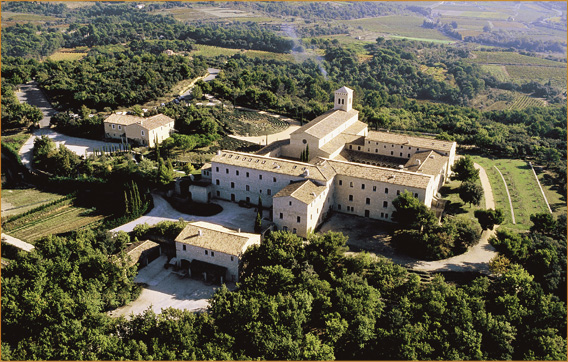
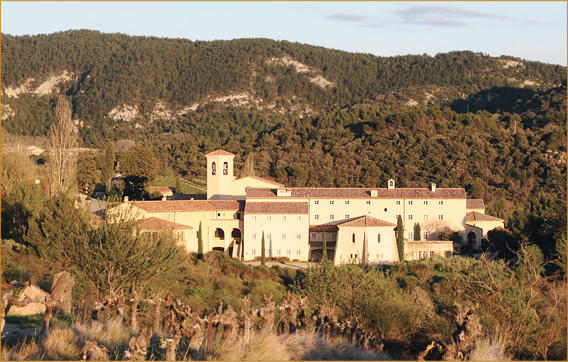
2010-2011 :
Friends support the monks’ efforts
December 2010 was a very important date for the Domain of the two abbeys: following a meeting with Jean-Dominique Artaud, then vineyard manager of the Domaine de la Janasse in Châteauneuf-du-Pape, the monks decided to bring their growing methods up to the same level as those of top vineyards, by following, with some flexibility, the main guidelines for organic agriculture. With unfailing dedication, Jean-Do continues to provide highly specialized advice and encouragement with regard to the potential of the Abbey’s vineyards to produce high quality wines.
Around the same time, Miguel Varo, generously offered his skills as an agronomy engineer specializing in the cultivation of grape vines and olive trees, to help the monks get the most out of their soil. His regular monitoring of every plot in the vineyard and his very attentive presence during the crucial period of the last weeks and the last few days before harvest make it possible to go as far as possible in obtaining the optimal ripeness for each variety, within the constraints of each vintage.
In 2011, these efforts invested in the vineyard allowed the monks to present a newer, more qualitative range: red wine from older vines (Ventoux St Roman), red from young vines (Ventoux St Louis) and rosé (Ventoux St Alric). 2012 saw our first white wine (Ventoux St Hilaire, made from Clairette and Roussanne grapes).
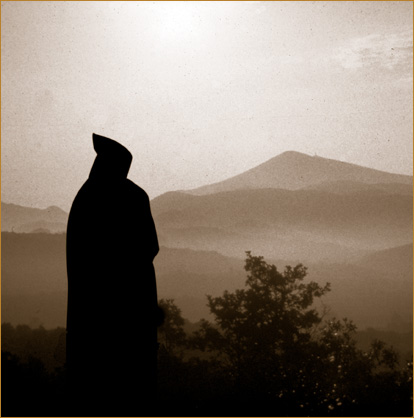
2012-2015 :
Boldly united with the Caritatis Winegrowers
In order to go as far as possible in producing high quality wines, the monks decided in early 2011 to join the very bold project initiated by their friends the winegrowers of Beaumont du Ventoux, and to embark on the creation of vineyard terraces. Like the winegrowers, the monks signed up to follow the specific requirements that would commit them to an extremely rigorous way of grape growing. It was true that, since the meeting with Jean-Do, many points of this method of grape production had already been adopted on our domain: increased trellis heights on the older plots, elimination of suckers, leaf thinning, very severe sorting of the grapes at harvest time… But the challenge of high-density planting (7,500 wines per hectare) remained, which was no easy task, involving trellises with wooden posts, and the meticulous removal of a proportion of the grapes while they are still green, to avoid overloading.
For the monks, it was the certainty of being able to improve the quality of their wines which guided this choice. The control and guidance of the Terraces Commission then enabled the application of the same methods to both of the Abbeys’ vineyards, which as a result benefitted from unforgettable panoramic views of the new terraces planted opposite Mont Ventoux.
In March 2012, the monks planted their first terraces under the watchful eye of the winegrowers who, with almost ten years’ experience, knew the difficulties inherent to the project. Everything had to be adapted to rows of vines planted 160 cm from each other, keeping control of the frequent landslides that occur during heavy autumn rains on these steep slopes, learning the art of controlling the quantity of grapes produced, monitoring the stress caused by dryness on the highest terraces that retain much less rain water, etc… It was almost like learning a new profession. But the first wines that had been produced in previous years from these types of plots were very promising, which was encouraging for the monks!
In 2013, the monks added to their terraces for red wine, planted with Grenache and Syrah, some terraces of Roussanne, because they also wanted strong structure, intense aromatic power, and an aptitude to age well for their white wines: high density planting would be a powerful asset.
In April 2016, two and a half acres of “Marselan” were planted on four terraces just above the sisters’ Abbey. Here the slope between each terrace can reach an altitude of nine meters. Planted in these conditions, this variety should enrich the red wine grapes that improve with age. Perched high on the fourth terrace, one is dazzled by the spectacle: in the foreground the other three terraces of young vines are visible; to the west are the foothills of Mont Ventoux; then back towards the south one sees the tile roofs of the sisters’ monastery and the valley planted with vines, with in the distance, on a peak, the castle of Le Barroux, which seems to protect the plains of Carpentras while at the same time watching over the brothers’ abbey perched on a twin peak; and finally, a little to the east, are the Dentelles de Montmirail, with their extravagant natural crenellations.
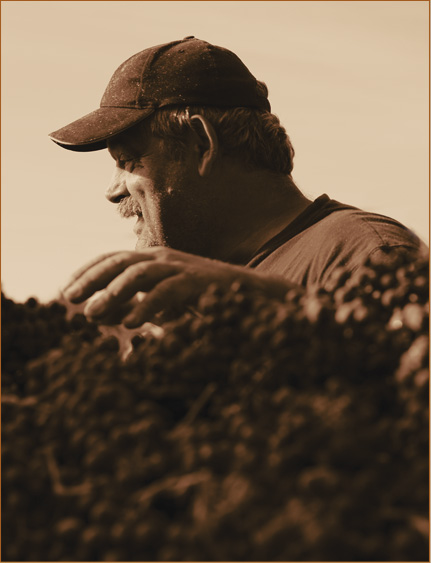
2016 :
CARITATIS A PATH OF EXCELLENCE – MONKS AND WINEGROWERS
The magnificent grape harvest of 2015 offered a fitting crown to the perseverance of the monks, nuns and winegrowers, and hints at the prospect of some superb wines.
Further providential encounters with prominent figures in the world of wine encouraged us to seal the bond between the two abbeys and the winegrowers, by creating a common identity that reflects what the monks, nuns and winegrowers all desire: the profound charity that inspired this project, the historical and spiritual heritage that they have inherited, the numerous friendships that have sprung from this adventure and the desire to share them through the creation of a noble wine, guided our choice of the name : VIA CARITATIS.
The President of the Wine Academy of France, Jean-Robert Pitte, honors us by supporting this commemoration of our monastic and papal wine heritage. The oenologist Philippe Cambie with his talent, experience and encouragement, has given us invaluable help with the blending of the different types of grapes to obtain the best possible wines. And Michel Trama, the renowned chef, has offered his expert advice in suggesting food and wine pairings.
The CARITATIS wines will be ambassadors for the best of the history, the wines, and the terroir of Provence. And we especially hope to participate in spreading a Spirit of Charity, which is at the heart of the terroir that produced them.
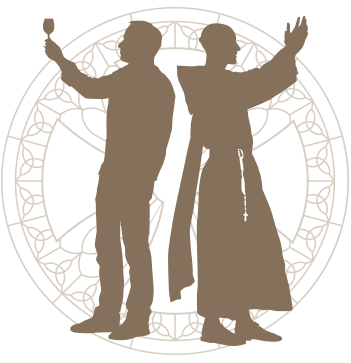
Thanks | CGV | Legal notices | Website by © Orkidées, 2021 - Pictures: © Odile Pascal
Abbaye du Barroux & Vignerons Caritatis
-
1201 Chemin des Rabassières - 84330 - Le Barroux - France
Tél : +33 (0)7 77 08 25 09 ou +33 (0)6 95 90 39 85
Fax : +33 (0)4 84 50 84 57
